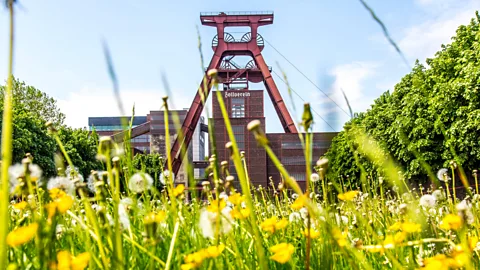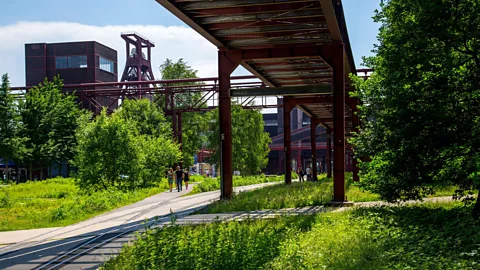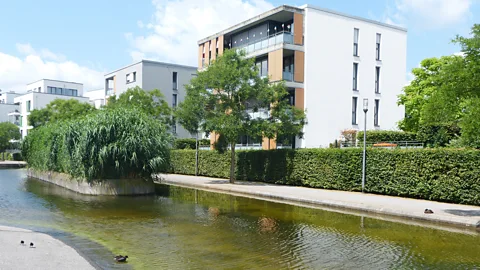Essen: Germany’s ‘ugly duckling’ city success
 Jochen Tack
Jochen TackThanks to an innovative approach, the German city has catapulted from an industrial wasteland to one of Europe's greenest cities.
Located in the heart of western Germany's long-time industrial Ruhr region, the city of Essen spent much of the past 150 years marred by pollution, tainted by filthy mines and belching factories and lined by poisoned waterways. In just one year in the 1960s, a study noted that some 1.5 million tons of toxic dust, ashes and soot rained down on Essen's inhabitants, along with four million tons of sulphur dioxide. But a remarkable transformation has seen Essen go from being Germany's ugly duckling to one of Europe's greenest cities.
"Green urban development has acted as a driving force in Essen over the last decade," explained Simone Raskob, who helped oversee Essen's transformation through a mix of so-called Blue Green solutions: "Blue" for water-focused initiatives, and "Green" for land-based projects. This two-pronged approach helped catapult Essen to be declared the European Green Capital for 2017.
Essen's most high-profile "Green" project is the transformation of the Zollverein industrial complex – once the world's largest coal and coke production facility – from toxin-spewing industrial blackspot to an inspiring eco-park granted Unesco World Heritage status. Inside its giant former coal washing building, the impressive Ruhr Museum enthrals visitors with displays on the site's history and transformation between towering old machinery. A short walk away, the Red Dot Design Museum showcases examples of innovative global design in a former boiler house building repurposed by renowned architect Norman Foster.
Ever since mining at Zollverein and the surrounding region ended in the late 1980s, woodland has spread across the vast site, and its trail-laced expanses are now home to more than 800 animal and plant species. "The slag heaps are so cool now, too!" added Florian Hecker, a green expert from Essen's city council. "You've got biking trails on them, concerts on them and art on them." Another of the Zollverein slag heaps, meanwhile, now provides a 60m-tall winter ski piste, as well as an ice skating rink.
 Jochen Tack/Alamy
Jochen Tack/AlamyHow to visit
Getting around:
Use MetropolRadruhr to rent a bike at pickup at points across the city and explore Essen using designated bike lanes. The 22km Essen Stadtbahn tram network is another excellent way to navigate the city.
Where to stay:
The Atlantic Congress hotel utilises sustainability practices to minimise its use of energy, water and plastic. Its restaurant uses local produce to cut food miles, too.
Where to eat:
Elsewhere, grab a table at Gärtnerei (meaning "market garden") for a changing menu of creative vegetarian and vegan dishes using produce grown in the restaurant's own garden.
What to do:
The Folkwang art museum and Grugapark botanical gardens are within easy walking distance of the Atlantic Congress hotel. Other key sites include the 9th-Century Essen Domschatz cathedral treasury, home to one of Germany's most significant collections of religious artwork, and the grandiose Villa Hugel mansion.
When to go:
Between May and September for the best weather.
"Zollverein is a role model for structural transformation not only in Essen but in the entire Ruhr area," said Hanna Lohmann, press officer from the Zollverein Foundation. "It vividly shows that everything is possible – going from mining coal to climate protection and culture."
Yet, Essen isn't resting on its green laurels and is continuing to add eco-friendly initiatives. A 100km cycling 'super-highway (dubbed the Ruhr RS1 and the more-colloquial "Route 66 for cyclists") is slowly taking shape atop old industrial railways. Since the highway's first 6km stage was completed 2015, linking Essen and Mulheim an der Ruhr, it's already estimated to have reduced carbon dioxide emissions by 16,600 tonnes per year. When finished in 2030, it will link the cities of Hamm and Duisburg with a series of paths traversing the wider Metropole Ruhr region.
A string of nature-walking trails have also been created in and around the city to help boost local engagement with – and appreciation of – natural habitats. In 2022, the 26km ZollvereinSteig route in the north of Essen was completed, while the latest addition is the 33km DeilbachSteig which connects Essen with the neighbouring towns of Velbert and Hattingen. All the trails are easily accessible by public transport.
More than 100 community-run urban farms have also sprung up across Essen, like the Bonnekamp Permaculture Farm, a beacon of biodiversity and food production that sells its organically grown products around the city. "Some people used to be amazed by old containers filled with carrots, kohlrabi or pumpkins, [but] today more and more people now understand that in these projects ideas of sustainable development are flourishing," said urban planner Dr Juliane von Hagen.
Among the city's many "Blue" transformations are the creation of lakes and ponds by harvesting rainwater. The lake at Krupp Park is fed by rainwater flowing down pipes from the roof of a building at the nearby steel and engineering giant ThyssenKrupp AG, while the Niederfeldsee lake pulls water from surrounding roofs to brighten another former industrial area. Duck-dotted rainwater ponds also frame student accommodation at Essen's new University Park.
Perhaps the toughest of Essen's "Blue" solutions involved restoring the River Emscher, considered a biologically dead "open sewer" since the end of the 19th Century, thanks to the dumping of mining and factory slurry and waste water.
 Norman Miller
Norman MillerAfter a two-decade clean-up programme, trout once again returned to the rejuvenated river in 2015. A recent count found more than 1,000 fish and animal species living along the Emscher, including previously endangered lapwings, kingfishers and beavers. The Emscher is also the focus of a 51km network of wastewater pumping stations that constitute the largest wastewater project in Europe.
Carbon Count
The travel emissions it took to report this story were 0.18 metric tons of CO2e. Find out more about how we calculated this figure here.
Though humans aren't yet encouraged to join the trout in the Emscher, an arena for swimming and boating hums with activity at Lake Baldeney, a broad expanse of water created behind a 9m weir on the similarly cleaned-up Ruhr river. When swimmers splashed here back in 2017, it was the first time bathing had been officially allowed on the Ruhr for 46 years.
From German eyesore to proud green city, Essen's green-and-blue approach isn't just benefitting outdoor enthusiasts and the environment but is also providing a shining example of how other cities can look to their industrial past to embrace a cleaner future.
Green Cities is a BBC Travel series that profiles innovative cities and towns around the world that are making bold strides towards a more sustainable future.
--
Join more than three million BBC Travel fans by liking us on Facebook, or follow us on Twitter and Instagram.
Sign up to the Future Earth newsletter to get essential climate news and hopeful developments in your inbox every Tuesday from Carl Nasman. This email is currently available to non-UK readers. In the UK? Sign up for newsletters here.
